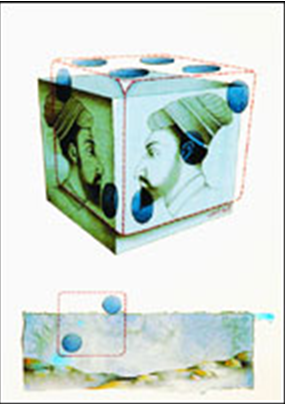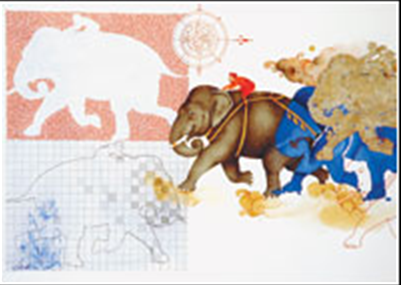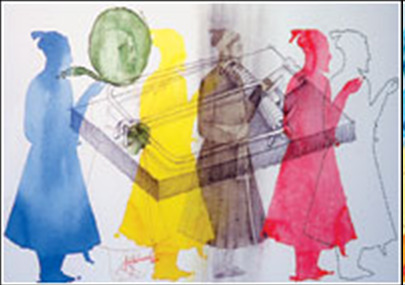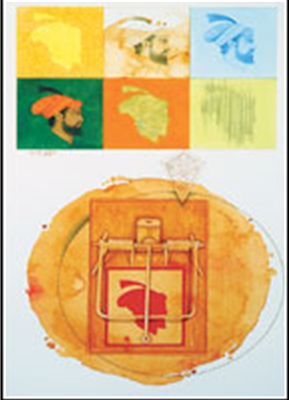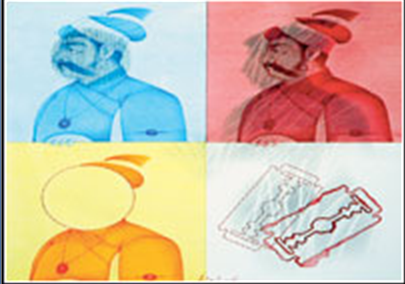Asif Ahmed
This is a collection of articles archived for the excellence of their content. Readers will be able to edit existing articles and post new articles directly |
Asif Ahmed
MINIATURE: The Old & The New
The Contents Of Asif Ahmed’s Compositions Speak Of Shifting Stands And Games Of Chance — An Allusion To The Current Climate Of Power Politics, Intrigue And Muscle Flexing. The Works Can Also Refer To Fate Of The Mughal Miniature Which Is Caught In A Time Warp, Writes Salwat Ali
Miniature took centre stage once again as a solo exhibition by artist Asif Ahmed, titled ‘Narration and transformation’ went on show at Karachi’s Chawkandi Art Gallery recently.
Catapulted into the 21st century, the Mughal miniature continues to somersault in a vast trajectory of contemporary thoughts and hybrid formations. While applications and styles abound, it is fine working skills and intelligent conceptual visualisations that separate the chaff from the grain.
Among the scores of new entries that keep surfacing, only a handful qualifies as class acts. A painstaking art, miniature painting demands a challenging degree of dedication, patience and ability to labour, from the artist. Solo exhibitions, usually few and far between, are thus strong determinants of an artist’s level of commitment to the genre.
Singled out for his thesis ‘Banjararama’ as early as 2004, Ahmed has been looked upon since as an artist with potential. He draws with a fine hand using deft and delicate brushwork to define his contents and successive exhibitions of his works in group shows manifest his ability to maintain his working skills. In ‘Narration and transformation’, the artist references the traditional miniature repertoire particularly the imperial profile in royal finery.
The ubiquitous elephant icon, arabesque patterns, scrolls, seals and stamps are other historical connections that he juggles with to build his content. Removed from its actual reality this vocabulary is placed among contemporary images of devices that trick the eye, cut, catch and kill. He has drawn mouse traps, razor blades and dice cubes to bring into play a ‘dislocation’ of elements.
The contents of his compositions speak of shifting stands and games of chance — an allusion to the current climate of power politics, intrigue and muscle flexing. The works also refer to fate of the Mughal miniature which is caught in a time warp. Wrested from the past the heirloom is still in limbo. Surrounded by flux and all manner of intervention, deconstruction and makeover, it is still searching for a composite identity that can define its status in the 21st century.
Integrating specific imagery of the past and the present into a harmonious whole in a painting can be tricky as both vocabularies speak of their own times. Ahmed is still struggling with the balance of the old and the new in his compositions.
There is friction between his images and icons as the mousetraps and dice cubes do not sit happily with his classical figurations. Moreover the imposition of these icons speaks of a forced/ deliberate effort to emulate the deconstruc- tion practice widely preva- lent in the miniature today regardless of whether it suits the temperament of the work or not.
As a miniature artist Ahmed is comfortable with the traditional ethos of the genre. He has a feel for the romantic and the ideal, and with minor changeovers from the conventional to the modern has managed to produce a few touchingly poetic works.
As an evolving artist he should concentrate on this flair for pictorial narrative and mine the fields of Urdu prose and poetry, folk legends and cultural history as possible sources of reference rather than opt for confusing attempts at radical changes.
There is friction between Ahmed’s images and icons as the mousetraps and dice cubes do not sit happily with his classical figurations.
